
How the Sun, solar system, and planet Earth formed and how life began are fundamental science questions that still remain unanswered. Today, we may be one step closer to answering these questions, because the spacecraft Philae, which is aboard the Rosetta, is in the process of landing on a comet for the first time ever. I was able to interview two of the scientists involved in this project to gain insight into how Rosetta’s mission may answer these very questions.
Comets
People have always been fascinated by comets. Perhaps you have witnessed the spectacular view a bright comet brings to the night sky. For thousands of years, however, they were mistaken for bad omens — until modern science recognized how remarkable they are.
Comets were formed at the outskirts of the solar system about 4.6 billion years ago. Since then, their chemical composition has basically remained unaltered, due to their relative isolation because of their elongated orbits around the Sun and orbital periods, which can be measured in hundreds or even thousands of years.
Carrying essential information about the solar system when it was still young, comets can provide insight into the origins and evolution of planets. Scientists believe comets played a crucial role in forming Earth’s oceans and atmosphere, since chemical compounds, such as water, were brought to the earth’s surface through cometary impacts. An even more extraordinary hypothesis is that as comets also contain complex organic molecules that make up life’s essential ingredients (amino and nucleic acids, for example), they helped contribute to the beginnings of life on Earth.
One of the goals of Rosetta’s mission is to help unlock the mystery of the planetary evolution, by studying comets.
The Mission: Unlocking the Mystery of Planetary Evolution
I had the opportunity to interview Dr. Carsten Güttler, the project manager for the OSIRIS camera aboard Rosetta, from the Max Planck Institute for Solar System Research in Göttingen, Germany. Dr. Güttler explained the importance of the mission, while showing me a model of the spacecraft, which is on exhibit at the institute’s atrium.
Dr. Güttler explained, “Comets are likely the key to the understanding of the origins of planets. That’s why the mission is named after the famous Rosetta Stone showing the same text in three different languages from which only one was understood at that time.”
Philae, Rosetta’s Lander
Dr. Güttler proceeded to give me an overview of Rosetta’s mission. He said, “Rosetta is a cornerstone mission of the European Space Agency, [and is] a very large and important project. For the first time, a spacecraft is sent to the comet and stays close to it. Until now, there were missions [that entailed] flying past the comets, but Rosetta is unique in the sense that it will accompany the comet for over a year and track how it develops and gets warmer and more active on its way to the Sun.”
Playing an essential role in the mission is Rosetta’s lander Philae, which is attached to the orbiter and will be able to track these developments. “On [the] 12th of November in the morning, the lander will be pushed off the orbiter and land on the surface of the comet,” Güttler noted.
He added, “With Rosetta, we have the possibility to observe the comet from a distance, while with the lander, we are sending a small laboratory to the comet in order to explore the comet on one location in the very detail.”
As Dr. Güttler mentioned, Rosetta will be the first spacecraft to fly alongside a comet, while Philae will make the first controlled landing on one. After Philae is released, it will fall towards the comet’s surface along a pre-defined trajectory and land on the surface after a free flight phase of about 7 hours. Upon the lander’s arrival, it will fire two harpoons to anchor itself to the surface, since the comet’s gravity is roughly ten thousand times weaker than our Earth’s.
Rosetta’s Journey to the Depths of the Solar System
The adventure began back in 2004, when Rosetta was sent on a 10-year-long journey towards the comet 67P/Churyumov-Gerasimenko.
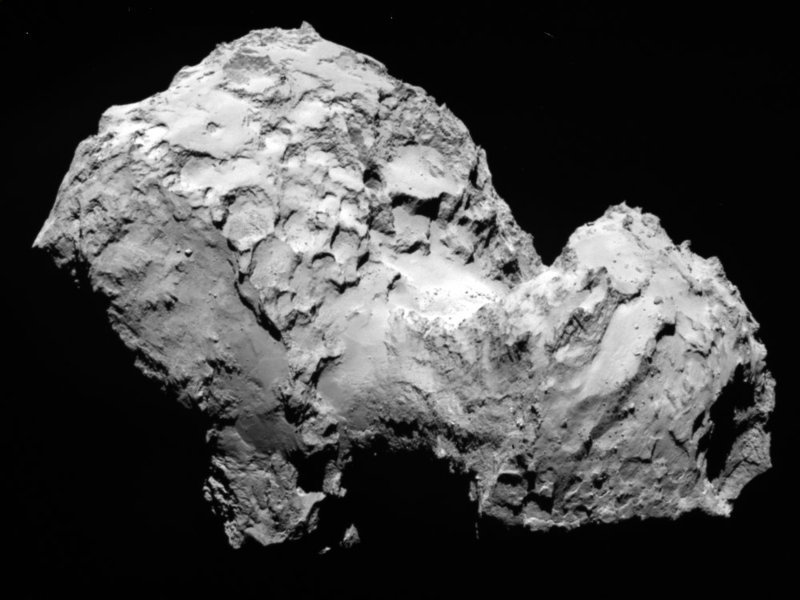
This image of the comet 67P/Churyumov-Gerasimenko was taken on August 3, 2014, from a distance of 285 kilometers. It shows a wide variety of surface structures, such as steep slopes and large plains. Image credit: ESA/Rosetta/MPS for OSIRIS Team MPS/UPD/LAM/IAA/SSO/INTA/UPM/DASP/IDA.
During this journey, Rosetta passed through the asteroid belt; had close encounters with two asteroids; and, to save energy, even entered into a deep-space hibernation for almost three years. When Rosetta awoke from hibernation earlier this year, the entire Rosetta team celebrated.
Rosetta Arrives at the Target Location
Rosetta arrived at its target location on August 6, 2014. When it did, it began a series of maneuvers to advance down to 8 kilometers away from the comet’s surface. During the approach, the Rosetta team searched for an appropriate landing site to ensure Philae’s solar cells would be able to receive enough solar energy. In addition, the team didn’t want the lander to become hindered by the comet’s rough terrain and planned to avoid any large boulders. Eventually, the team finally chose a landing site, which was named Agilkia.
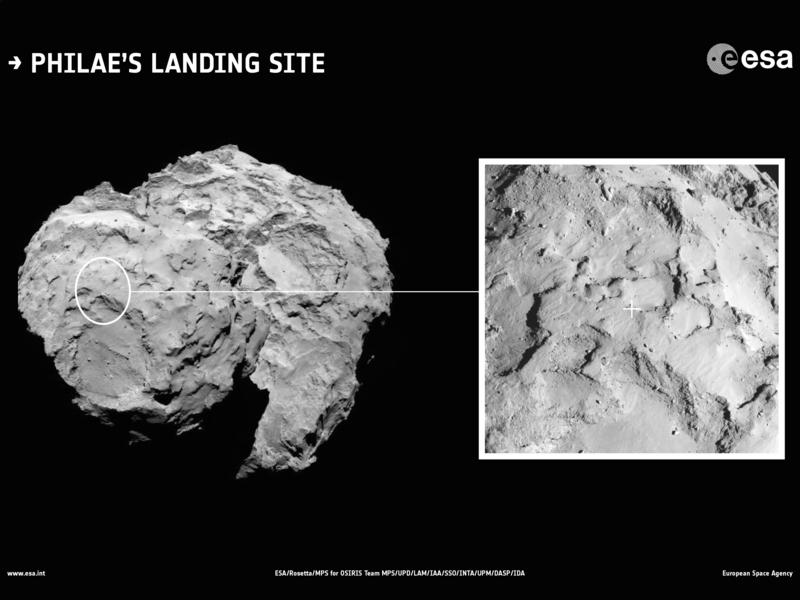
Agilkia is located on the “head” of the comet. In the close-up image, on the right, it’s marked with a cross. Image credit: ESA/Rosetta/MPS for OSIRIS Team MPS/UPD/LAM/IAA/SSO/INTA/UPM/DASP/IDA.
If everything goes well, Philae can start its mission on the comet right after landing.
On the long trip to its target location, the spacecraft already achieved many historic firsts. It is the first spacecraft to orbit a comet, as well as the first spacecraft to fly so far away from the Sun, using solar cells as the main power source.
Exploring the Comet’s Surface with Simulations
On-board, Rosetta and Philae carry more than 20 different instruments that will explore the comet’s surface and interior upon landing. One of them is an instrument called MUPUS (Multi-Purpose Sensor for Surface and Subsurface Science), which was developed under the leadership of the Institute for Planetary Research of the German Aerospace Center (DLR), located in Berlin, Germany. As the comet approaches the Sun, MUPUS is specifically designed to measure the thermal and mechanical properties of the comet’s surface, as well its evolution over time.
Developing a Model
A team of researchers from the Space Research Institute of the Austrian Academy of Sciences in Graz, Austria and the Institute for Planetary Research in Berlin, used COMSOL Multiphysics to develop a model to help them interpret thermal measurements that will be made by MUPUS. The team composed the paper “Interpretation of Measurements with Novel Thermal Conductivity Sensors Suitable for Space Applications” and presented it at the COMSOL Conference 2011 Stuttgart.
The principal author of the paper, Dr. Norbert Kömle, from the Space Research Institute in Graz — who has been involved since the beginning of the project — told me, “Imagine it this way; the comet body is a mixture of ice and rock: partially mixed, partially separated, and partially loose. We want to determine the properties of the surface, not by looking from outside, but by inserting a probe into the material.”
Such a task, however, poses a dilemma. As Kömle pointed out, “It’s challenging, because the lander has to land on a rough terrain, avoid any small rocks, and stay up-right. If it’s successful, it will really be, without exaggerating, a historical achievement.”
MUPUS consists of a roughly 40-centimeter-long glass fiber rod that contains 16 individual heaters and sensors. Each of them can be turned on and off separately, in order to measure the variation of thermal conductivity over the length of the probe. At the top, there is a hammering device used for fixing the probe and measuring the mechanical properties of the surface.
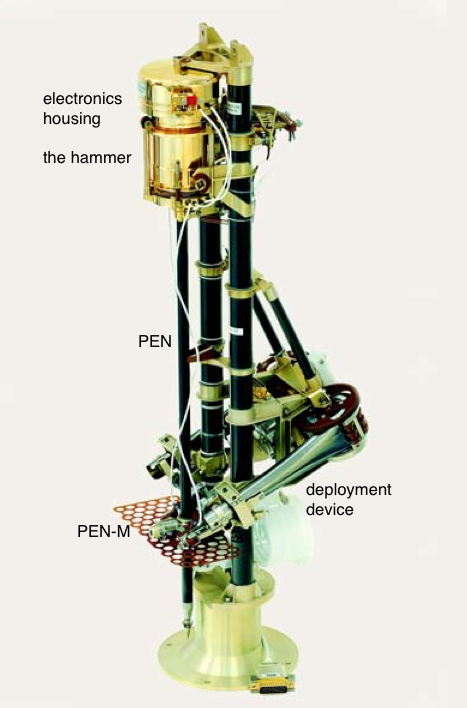
The MUPUS experiment aboard the lander Philae. From Kömle et al., COMSOL Conference 2011 Stuttgart.
Investigating the Involved Phenomena
Dr. Kömle’s team used the Heat Transfer Module, an add-on to COMSOL Multiphysics, to develop a model that’s able to derive the thermal properties of the comet’s surface, such as thermal conductivity, from the measurements.
In their model, they considered a realistic sensor geometry, axial heat losses in cylindrical sensors, and thermal resistance between the probe and the surrounding material. Dr. Kömle and his colleagues also used the COMSOL simulation software to calibrate the MUPUS probe and its variant EXTASE, which is made for terrestrial measurements. They used predefined radiation boundary conditions to simulate the shielding and cooling of the probe.
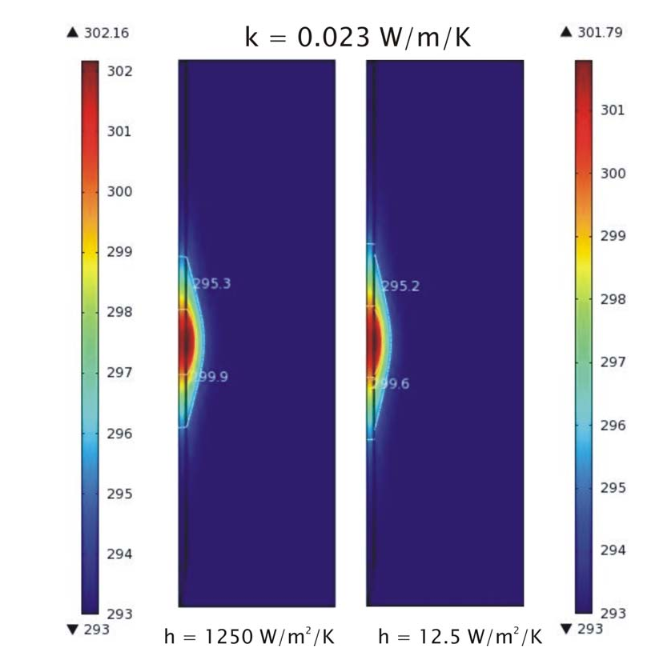
Influence of thermal resistance between the conductivity sensor and surrounding soil for a lunar regolith under lunar pressure conditions (vacuum). The range of thermal conductance varied from 1250 W/m2/K (representing a good material contact between the probe and the soil) and 12.5 W/m2/K (no air, no direct material contact). From Kömle et al., COMSOL Conference 2011 Stuttgart.
Simulations Prove to Be Vital to the Mission
Simulations are vital to the Rosetta mission. Dr. Norbert Kömle continued, “Simulations are especially important here, because we want to determine the surface properties. For example, how deep the [heat generated by the] solar radiation penetrates the comet’s surface. This depends on what kind of material covers the surface — ice or some other porous material. This cannot be calculated directly, but it’s also dependent on the geometry and the structure of the sensor. Therefore, we have set up a COMSOL [Multiphysics] model, changed different parameters in the model, for example thermal conductivity, and compared the model with our measurements in the lab and in the field.”
By changing the parameters, the researchers can see how fast the heat spreads in the surrounding material. Since the data from the comet are not yet available, simulations play a key role. “The comet’s surface can also be made of different layers, such as ice, dust, or frozen soil,” said Dr. Kömle. He added, “COMSOL [Multiphysics] did a very good job here for developing our models and to make the whole process more efficient.”
Dr. Kömle’s team continues to use COMSOL Multiphysics for other applications, too — one of which is the modeling of thermal evolution of crevasses on the comet’s surface and how they change, due to the sublimation and gas jets at the surface. “COMSOL [Multiphysics] proved also very useful here,” said Dr. Kömle.
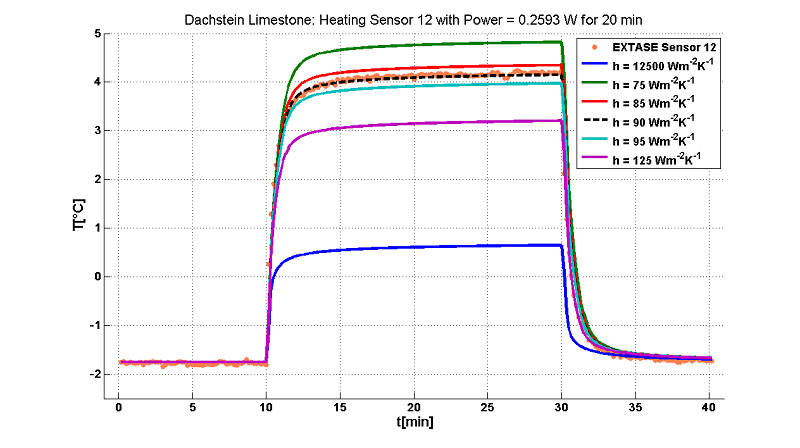
Comparisons of EXTASE measurements in alpine rocks and COMSOL Multiphysics simulations for terrestrial applications. Courtesy of Dr. Norbert Kömle.
A Historical Mission
The whole Rosetta and Philae mission was built by several space agencies, scientific consortia from institutes across Europe and the United States, and the industrial team involving more than 50 contractors. It represents significant scientific and technological challenges, which have to be met in order to fulfill the mission’s ambitious scientific goals.
The Rosetta team has already received a lot of impressive data; “The images are spectacular. They are already inspiring us to imagine, for example, some snowy winter landscapes down there. There is, of course, no snow, rather dust covering the surface. We also see cliffs and different erosion features. One can ask oneself, ‘How was all this formed?’ Until now, we actually saw how much we don’t know, but that makes this mission so fascinating,” Dr. Güttler remarked.
Confirmation of the landing is expected around 16:00 GMT today (November 12, 2014), so let’s cross our fingers that it will be successful. As Dr. Güttler put it, “I believe, after the Rosetta mission, the history of comet research will have to be rewritten.”
UPDATE (11/12/2014): Touchdown officially confirmed at 16:03 GMT!




Comments (0)